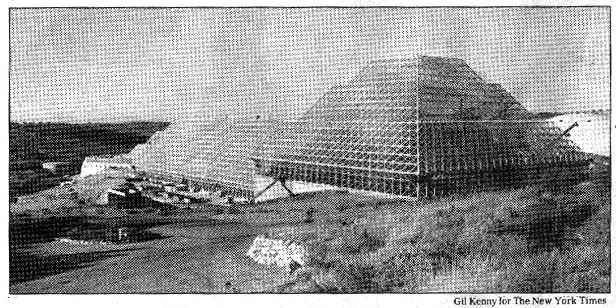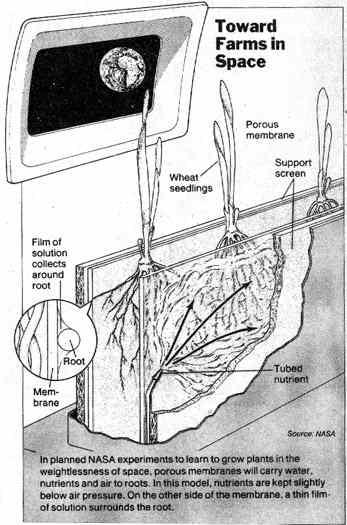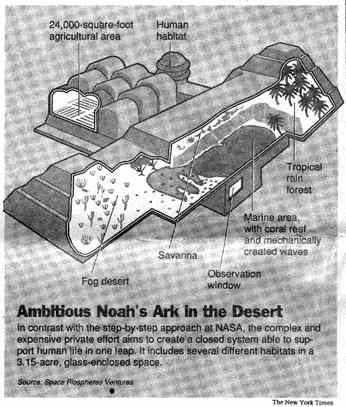
Biosphere 2 in Oracle, Ariz., where eight people plan to spend two years. The eight-story complex covers 3.15 acres and will contain 3,800 species of plants, as well as a variety of animals. The glass-enclosed environment costs about $100 million.
NEW YORK TIMES, Science Times, Tuesday, November 6, 1990
Copyright © 1990 The New York Times

By WILLIAM J. BROAD
As space enthusiasts in Arizona prepare to seal themselves inside an eight-story, $100 million greenhouse for two years, an event tourists can commemorate with T-shirts and other memorabilia purchased at the nearby gift shop, the scientific field that parallels their endeavor has been making quiet progress beyond the limelight.
 Both ventures are bids at futuristic recycling, studying how green plants can take human wastes (urine, feces and carbon dioxide) and turn them into oxygen, water and food for humans living in closed spaces. The result would be a closed, independent, self-contained system in which plants would provide all material sustenance for the humans, including food.
Both ventures are bids at futuristic recycling, studying how green plants can take human wastes (urine, feces and carbon dioxide) and turn them into oxygen, water and food for humans living in closed spaces. The result would be a closed, independent, self-contained system in which plants would provide all material sustenance for the humans, including food.
The ultimate aim of both groups is to help astronauts cut supply lines to Earth and roam the universe at will. That is no mere fantasy: the White House's bold plans to turn to the Moon and venture onward to Mars may require just such recycling.
But while ends of the two groups are similar, the means to achieve them are very different, illustrating the divergent paths science can take. The contrasting methods are partly a result of different types of financing, one private, the other public. But while the government has traditionally pursued far out ideas, with industry lagging behind, space-age entrepreneurs in this case are boldly going where no one has gone before.
In Oracle, Ariz., the four men and four women of Biosphere 2 (they refer to the Earth as Biosphere 1) are entering a realm more akin to Noah's ark than a laboratory. Their exotic 3.15-acre, glass-enclosed habitat, containing some 3,800 species of plants as well as fish, chickens, goats and pigs, is to produce all their physical needs for two years, starting early next year. It is to be a little Eden or Shangri-La. All are single and free to form whatever relationships they wish. Their dream is to erect such a structure on Mars.
Biosphere 2 is a privately financed, all-or-nothing experiment. The glass habitat, which is to last a century, is so expensive and bold that no government or scientific center would be likely to pioneer one.
In contrast, scientists at universities and the National Aeronautics and Space Administration are taking a step-by-step approach that centers on first mastering the basics of plant-human relationships, usually by focusing on a single plant, and then applying those insights to the design of small systems that could enter space far sooner than the mammoth structures of the Arizona group. Their life-support systems could be used in space stations, ships or planetary outposts. The NASA scientists have been at it for more than a decade, and their work has been picking up speed of late.
Genetic engineers at Purdue University are now working to improve the productivity of candidate plant species. Researchers at the Kennedy Space Center in Florida are growing wheat under artificial light in a closed chamber, achieving up to 80 percent of the growth in sunlight. And soil scientists at the Johnson Space Center in Houston are raising lettuce in mock lunar soil, seeing what might prosper at a Moon outpost.
The two groups keep close tabs on one another, partly out of friendly rivalry. "It comes down to what is science, and what are the right questions to ask," said Dr. Robert D. MacElroy, chief scientist of the advanced life support division at the space agency's Ames Research Center in California.
The Biosphere 2 project, run by Space Biosphere Ventures, a private ecological research firm, says its vision to create a complex ecosystem from scratch is just as scientific but more holistic. Its aim, according to a company brochure, is to "greatly enhance our understanding of our present biosphere" and pioneer the "means of establishing permanent stations in space or on other planets as research bases and eventually settlements."
Kathleen A. Dyhr, a Space Biosphere spokeswoman, said the distinction between the two groups was "systematists versus reductionists," or experts who look at whole systems versus ones who break them into component parts, adding that "war between these schools of thought has been going on for a long time." The Biosphere approach, she said, mimicked the complexity of the planet and sought to better understand that intricacy.
"With the Earth, we have a lot of detailed information on the parts but don't know how it all fits together," Ms. Dyhr said. The group says even a life-support failure (they joke about everything turning into green slime) would be a qualified success, since much would be learned in the process.
Dr. Arthur W. Galston, a Yale University botanist who advises the NASA program, said the Arizona group was "flaky" but provocative. "They're looking at areas that haven't been looked at before," he said.
Both efforts were ultimately important, Dr. Galston said, "because they're a paradigm of what man here on Earth has to face" in years ahead. We have a burgeoning population," he said, "a decline of arable land, and waste heaps that are growing continuously. We have to find ways of producing more food in less space to feed more mouths, with less nonrecyclable refuse. This work is going to have a lot of civilian spinoffs."

Keeping Astronauts Alive
Today, the usual way of keeping astronauts alive in space is with a continuous supply of food, water and air. On the space shuttle, oxygen and nitrogen are mixed into artificial air. After breathing, this mixture is passed through canisters that remove exhaled carbon dioxide.
Also aboard the shuttle are fuel cells that mix oxygen and hydrogen to produce electrical power and drinking water. Excess water vapor in cabin air is condensed and placed in waste tanks. Liquid wastes like urine, perspiration and lung vapor are periodically shot into space. Solid wastes, including feces and vomit, are exposed to the vacuum of space for drying and stored aboard the spacecraft.
The economic penalties for what NASA calls its "Physico-chemical" life support system add up fairly quickly. The average astronaut needs about 10 pounds of consurnables every day, including 1.3 pounds of food, 6.27 pounds of water and 1.76 pounds of oxygen. Because of these and other demands that tax storage space, shuttle missions are usually limited to about 10 days. Moreover, the cost of shipping these supplies into space is high, running about $5,000 a pound.
One path is plodding; the other, a $ 100 million effort, seeks change all at once.
NASA's planned space station, which would be manned year round, will need huge amounts of fresh supplies on a continuous basis. Studies show that if life-support equipment weighs 5 tons at first deployment the total weight will reach nearly 10 tons after the first year, nearly 15 tons after the second, nearly 20 tons after the third, and so on.
In theory, "bioregenerative" life support could cut that climb. The initial investment would be greater, owing to the greater bulk of plants and a larger array of equipment. For instance, bioregenerative life-support equipment might weigh 12 tons at deployment rather than 5 tons, according to contractor studies. But, in theory, hardly anything else would be needed - certainly no food, water or oxygen - once the apparatus was installed and running.
Many billions of dollars would be saved for long missions like that of the space station, which is to operate for more than three decades. Indeed, bioregenerative life support, with technology now on the horizon, is seen as being cheaper than the physicochemical alternative for any space mission whose duration is slightly longer than a year.
Such considerations prompted NASA to start an effort to master bioregenerative life support in the late 1970's. But there was little enthusiasm within the agency's upper ranks. The program went against the can-do, hard-edged, mechanistic philosophy of many NASA officials, who quietly dismissed it as mushy and ecological.
"Fundamentally," recalled Dr. MacElroy of NASA's Ames center, "there was a philosophical resistance, a feeling that hard machines had done it in the past" and would do it in the future.
Aims of Program
But the bioregenerative program, which received some $30 million in the last decade, nonetheless made headway. The goals have mainly been to develop plant-growth equipment and to evaluate different species and improve their productivity by such means as raising carbon dioxide levels and growing temperatures. This work, done mainly at NASA-financed universities, has found wheat to be an especially good candidate.
At the space center in Florida, work got under way in 1985 to apply these lessons to a closed test. Completed in 1987, the growth chamber, 24 feet high and 11 feet wide, has now grown five crops of wheat, two of soybeans, and is scheduled to try lettuce, rice, peanuts as well as sweet potatoes. Researchers are also working to make meals out of candidate plants and to find efficient ways to process wastes back into fertilizer and other usable products.
At Kennedy, a feeding method known as thin-film hydroponics uses water about an eighth of an inch deep rather than soil to carry nutrients. So far, scientists have used regular plant food rather than human wastes.
Starting this year, they plan to slowly introduce human liquid wastes for nutrients, and later human-type waste gases to the air. By 1993, their chamber should be able to chemically mimic the consumption and excretion of one person. If financing materializes, the scientists hope to build a new experimental apparatus in 1995 that would house three to four human volunteers for full-fledged tests.
Dr. William M. Knott 3d, who directs the work at Kennedy, said aspects of it might be tested in space as soon as 1991 on flights of the space shuttle, with attention focusing on a zero-gravity nutrient membrane that is seen as solving the vexing problems of weightlessness by feeding plant roots directly. But perfecting the whole recycling idea might take decades, he cautioned.